Hong Kong protests: Celebrities, big brands and China's media game
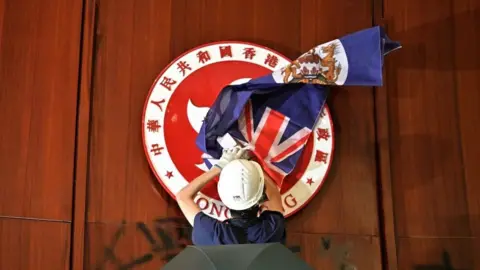 Getty Images
Getty ImagesWhen the Hong Kong protests first started, there was silence from China's state media.
But that changed as violence escalated to unprecedented levels and now China is trying to match the intensity of the demonstrations with an aggressive and creative media campaign of its own.
On social networks like Weibo and WeChat, there have been four key points - conveyed subtly and explicitly - that China really wants to get across:
- the black-clothed protesters are violent extremists who are Western lackeys
- there is support from many across Hong Kong for China - "the motherland" - and for the police
- Hong Kong needs to be reminded of China's military might
- Hong Kong is part of One China.
It's used celebrities and even, somewhat unexpectedly, the 1980s British miners' strike to make these points.
1. A policy of silence
The protests were sparked by a controversial and now suspended extradition bill, which would have allowed Hong Kong to send criminal suspects to the mainland. China's first reaction was ... to say nothing.
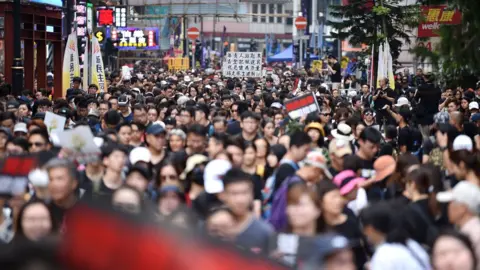 AFP
AFPSince then it has become a far broader movement calling for democratic reform as well as an investigation into police brutality - it's a rallying cry against China and perceived encroachments by Beijing.
Even when large-scale protests involving hundreds of thousands of people made international headlines on 9 June, Chinese-language media was silent. As weeks passed and with protesters reportedly growing to two million at their peak on 16 June, China muted all conversation.
This is partly down to the traditional tool of outright censorship. Posts containing terms related to the protests, including "Hong Kong", "Hong Kong government", and even specific terms like "1.03 million" (the reported number of protestors on 9 June), "Causeway Bay" and "Victoria Park" (areas where protestors were gathering) were censored from 9 June on the Sina Weibo microblog.
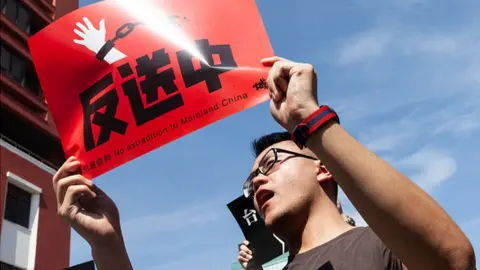 NurPhoto/Getty Images
NurPhoto/Getty Images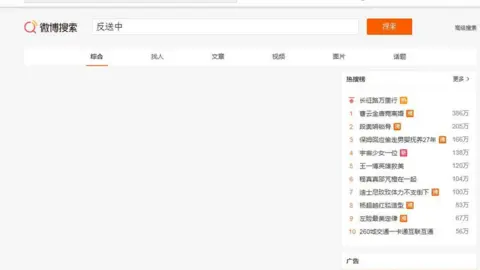 Sina Weibo
Sina WeiboChinese media even went so far as to say the bill had met with a positive reception, with news agency Xinhua declaring the extradition bill was "supported by mainstream public opinion". English-language papers acknowledged "small scale" demonstrations but said that hundreds of thousands "had pledged support in a city-wide signature campaign.
Still, no Chinese-language media made mention of protests. But it soon became clear this policy wasn't working.
2. Battle between 'foreign agents' and 'the motherland'
 Getty Images
Getty ImagesThen on 15 June, the extradition bill was suspended by the Hong Kong government - in an apparent victory for popular protest. At that point China's foreign ministry voiced strong criticism, and began blaming the US.
Official media said on 17 June that parents were taking to the streets "to urge US politicians to not interfere with [Hong Kong's] extradition bill and its internal affairs".
Just a few days later, when demonstrators defaced China's Liaison Office in Hong Kong, government mouthpiece People's Daily launched an angry front page editorial saying "the central authority will not be challenged".
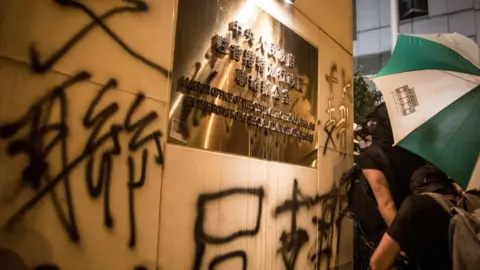 Getty Images
Getty ImagesSuddenly, en masse, state media began reporting on "radical protesters… destroying facilities, defacing the national anthem, and painting graffiti that insulted the country and the nation".
A policy of censorship was transformed into a sustained attempt to own the narrative on Hong Kong. More than 160,000 Weibo users used the hashtag #TheCentralAuthorityWillNotBeChallenged, and so China's media machine sprung into action.
Domestically and overseas, media also began replicating the slogan "Hong Kong is China's Hong Kong", especially in response to UK politicians' criticism of China's intervention in the Hong Kong protests.
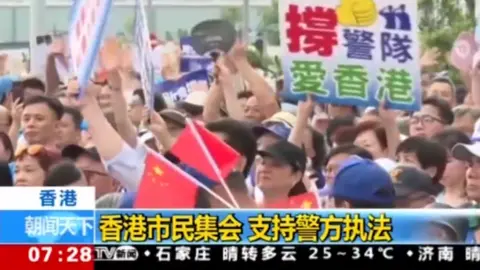 CCTV-13
CCTV-13Throughout the protests, media highlighted individuals who spoke up for mainland China and the protests have been labelled as pro-Western "colour revolutions" - a reference to the pro-democracy wave that overthrew governments in former Soviet nations in the 2000s.
Perceived double standards in Western media became a prominent theme at this time.
3. Battle of good-versus evil
When on 21 July, mobs of men wearing white-shirts suddenly appeared in Hong Kong's Yuen Long district and started beating black-clothed protesters, they were immediately painted in Chinese media as ordinary disgruntled members of the public.
In Hong Kong, they were painted as groups of thugs affiliated to gangsters called triads - but in China's re-telling of this event the white versus black motif was immediately transformed into a dialogue of good versus evil.
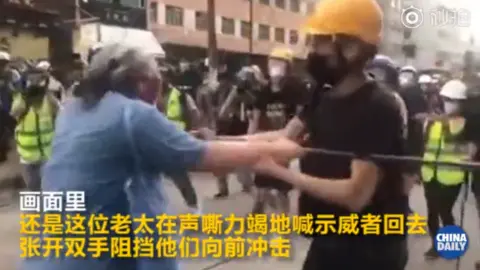 China Daily
China DailyThe increasingly violent confrontations allowed China to pick through imagery from the protests and paint those on the streets as radical and violent extremists.
Social media accounts began springing up on Facebook and Twitter from users with associations to the Chinese government, in a co-ordinated effort to amplify this dialogue overseas.
Allow X content?
Both Facebook and Twitter said they had removed a number of accounts that they believed were being used as part of a state-backed misinformation campaign.
Their claims were credible, given that China has proven domestically that it has the power to influence social media discussion on a huge-scale.
China has a well-documented history of recruiting what are known as the wu mao or "50-Cent Party": social media commentators who are paid a small amount of money to manipulate public opinion on a large scale online.
4. Using powerful symbols from history
From the Cultural Revolution to the British Miners' strike, historical precedent has been one tool to influence the narrative on Hong Kong in China's favour.
Media began labelling four veteran Hong Kong pro-democracy figures as a new "Gang of Four"- drawing on the dreaded language of the Cultural Revolution, it was a term that referred to the political faction blamed for the worst excesses of that time in China's history.
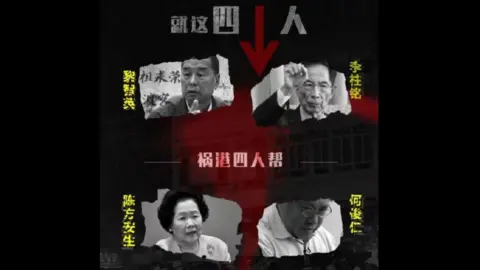 Xinhua News Agency/Sina Weibo
Xinhua News Agency/Sina WeiboThe circumstances of Hong Kong's handover frequently cropped up - a reminder that post-1997 the UK should have no involvement in Hong Kong.
Increasingly, media have shared footage of what they say are Western nations' own poor handling of protests and accused such countries of hypocrisy.
One example on 21 August showed official broadcaster CCTV sharing footage of British police officers being heavy-handed with protestors during the 1984 UK miners' strike and the 2011 England riots.
5. The foreigners who love China
A stream of foreigners who have nothing but praise for China and hard words for Hong Kong's protesters have also featured prominently in Chinese media.
Foreigners who are filmed arguing with pro-democracy protesters in favour of Chinese sovereignty are the ones most singled out for favour.
There was the Australian national arguing with protesters at Hong Kong's International Airport, and the Greek man arguing with pro-independence protesters in Australia.
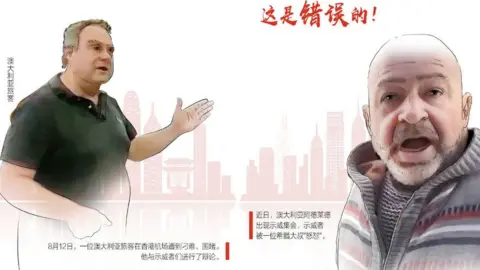 CCTV/Sina Weibo
CCTV/Sina WeiboApparently spontaneous vox pops with foreigners expressing support for China also have begun to feature heavily on Chinese state media social media feeds.
The Australian man, only identified as "Paul", has been praised by official media for telling protesters: "It is recognised all around the world that Hong Kong and Taiwan are actually part of China. That's actually recognised. Everyone, every country recognises it".
Pro-China rallies organised by overseas Chinese in the UK, Germany, Canada and Australia, for example, have received fulsome coverage. The counter rallies get little mention.
6. China's brand 'witch hunt'
An online assault against major luxury brands that had somehow failed to list Hong Kong, Macau or Taiwan as part of greater China also became a force to reckon with.
At its height - between 8 and 15 August - a series of global brands from Versace to Calvin Klein and Swarovski were targeted by social media users and were forced to issue apologies.
With the ever-present threat of a boycott in one of the world's most lucrative markets, the apologies were fulsome. Versace said it "loves China" and leading brands over and over again expressed their support for One China.
It was not the first time that social media users took up nationalist cudgels against major brands and state media lost no opportunity to report this.
7. Celebrity 'endorsements'
The government has also subtly underlined the power it has over celebrities, by highlighting where stars have shown their support for Beijing's stance.
Many stars including boyband member Jackson Yee and model Liu Wen severed their endorsement of companies that came under fire by China's press, possibly to avoid being implicated in the issue.
Others began showing they were good role models by jumping on a bandwagon of support for the government's message.
Liu Yifei, the actress set to play Mulan in the upcoming Disney film, received mass criticism on overseas social networks, after users highlighted that she had reposted a viral pro-police comment on 16 August on Sina Weibo.
But Ms Liu was only one of many celebrities, who shared a post by the official CCTV, saying "I also support the Hong Kong police".
 DISNEY
DISNEYMany on Twitter saw this as her toeing the Chinese government line in order to curry favour with China, and were critical, given she is an American citizen.
Mainland celebrities have been put on a pedestal from the state for supporting Beijing's message; but China has also highlighted where heavyweight Hong Kong celebrities have reinforced their support for Beijing, including actor Jackie Chan and singer Eric Suen.
On 13 August, Chan told CCTV that he was a "guard" of the national flag, and that he felt events in Hong Kong were "sad and depressing".
BBC Monitoring reports and analyses news from TV, radio, web and print media around the world. You can follow BBC Monitoring on Twitter and Facebook.
